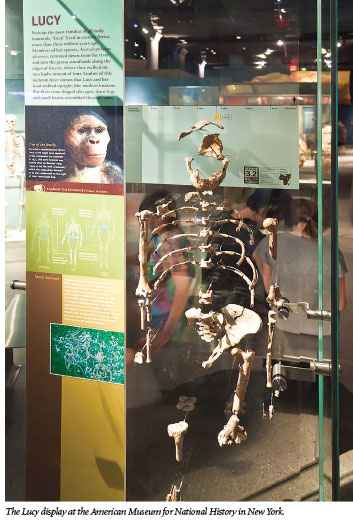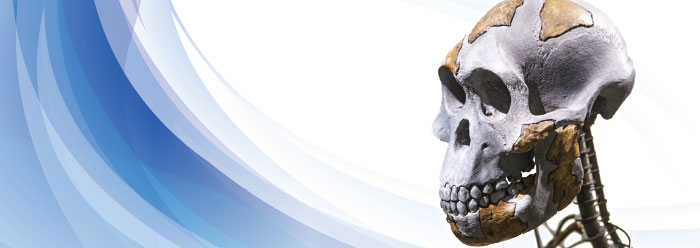Human evolution has consistently been shown to be without scientific or biblical merit. Although a parade of supposed transitions are displayed in every conceivable outlet, non-Darwinists maintain that the links between people and our alleged ape-like ancestors are—missing.
Perhaps the premier and most popular purported evolutionary relative of man is Australopithecus afarensis, or southern ape of Afar—better known as Lucy.1 Several hundred pieces of fossilized bone were discovered in east Africa by paleoanthropologist Donald Johanson and graduate student Tom Gray in 1974. Lucy is dated by evolutionists to be 3.75 to 3 million years old, and evolutionists have stated her line “probably evolved directly from [Australopithecus] anamensis.”2
How are creationists to respond to this compelling creature that supposedly links us to non-human ancestors millions of years ago?
To begin with, many people are not aware of the subjectivity that is involved with piecing together shattered fossil remains. For example, two evolutionists stated in regard to Lucy:
The sacrum and the auricular region of the ilium are shattered into numerous small fragments, such that the original form is difficult to elucidate. Hence it is not surprising that the reconstructions by Lovejoy and Schmid show marked differences.3
Not only do these bone pieces have no dates on them, but no one can be absolutely sure they are even from the same individual. The pieces fit where the biased researcher would like them to go. Whatever fragments are missing must be filled in with plaster of Paris and imagination.4 This is certainly true with Lucy. Her bones are what would be expected on the basis of creation: “Lucy’s fossil remains match up remarkably well with the bones of a pygmy chimp.”5
Anatomical evidence shows this creature was ape-like with a nonhuman gait.6 She knuckle-walked and climbed trees. Visitors to natural history museums, however, see a reconstructed creature behind the glass with a posture deceptively erect and humanlike. These displays show Lucy with an intelligent stare and skin color and hair added by an evolutionary artist who never saw her when she was alive and must guess the majority of her reconstructed features. Johanson agreed Lucy’s mandible (jaw) was V-shaped or ape-like, nothing like that of a human, who has a U-shaped mandible.
Her jaw was the wrong shape….I interpreted other things in her dentition [teeth] as primitive also, as pointing away from the human condition and back in the direction of apes….The larger jaws had some of those same primitive features.7
 In spite of evidence “pointing back” to apes, Johanson was determined to see Lucy as a human ancestor. His bias is revealed by his interpretation of a single arm bone he discovered in the sand. He stated:
In spite of evidence “pointing back” to apes, Johanson was determined to see Lucy as a human ancestor. His bias is revealed by his interpretation of a single arm bone he discovered in the sand. He stated:
This time I knew at once I was looking at a hominid elbow. I had to convince Tom [Gray], whose first reaction was that it was a monkey’s. But that wasn’t hard to do.8
Other fossil fragments fail to fit the evolutionary picture. Lucy’s shoulder blade was “virtually identical to that of a great ape and had a probability less than 0.001 of coming from the population represented by our modern human sample.”9
Despite the displays of Lucy at the St. Louis, Missouri, zoo and the natural history museums of New York and London as having human feet and hands, she in reality had short, curved toe and finger bones.10 (People have no curvature in these bones.) In addition, Lucy had a locking hand joint, while people are designed with a non-locking hand joint.
A chance discovery made by looking at a cast of the bones of “Lucy,” the most famous fossil of Australopithecus afarensis, shows her wrist is stiff, like a chimpanzee’s, Brian Richmond and David Strait of George Washington University in Washington, D.C., reported. This suggests that her ancestors walked on their knuckles.11
Recently, it was reported that Lucy “had an exceptionally powerful upper body, thanks to spending a lot of time climbing trees.”12
Her brain case (415 cm) was not enlarged and was the same size as the common chimpanzee. Lucy’s rib cage was conical-shaped (as found in apes), while humans have a barrel-shaped rib cage. As paleontologist Peter Schmid at the Anthropological Institute in Zurich, Switzerland, stated:
When I started to put the skeleton together, I expected it to look human. Everyone had talked about Lucy as being very modern, very human, so I was surprised by what I saw. I noticed that the ribs were more round in cross-section, more like what you see in apes. Human ribs are flatter in cross-section. But the shape of the rib cage itself was the biggest surprise of all. The human rib cage is barrel shaped, and I just couldn’t get Lucy’s ribs to fit this kind of shape. But I could get them to make a conical-shaped rib cage, like what you see in apes.13
Returning to the pelvis, evolutionists determined that Lucy was more likely a male due to the pelvis being heart-shaped and ridgeless.
Consequently, there is more evidence to suggest that AL288-1 was male rather than female. A female of the same species as AL288-1 would have had a pelvis with a larger sagittal diameter and a less protruding sacral promontorium....It would perhaps be better to change the trivial name to “Lucifer” according to the old roman god who brings light after the dark night, because with such a pelvis “Lucy” would apparently have been the last of her species.14
Why are hominids like Lucy depicted as walking upright? Even evolutionists admit that “the origin of bipedalism, the key event in the evolution of hominids, remains a mystery.”15 Regardless, because a half-femur and half-pelvis were found, evolutionists maintain Lucy walked upright, which they consider evidence that it was on the evolutionary road to people (Homo sapiens). But is upright walking the litmus test for the chimp-to-man transition? Non-Darwinists maintain that the bonobo (Pan paniscus) of today walks upright perhaps 10% of the time but this hardly means it is our ancestor. In fact, there has been some disagreement over just how “modern” the bipedalism of Lucy was.16 A recent study suggested:
Even when Lucy walked upright, she may have done so less efficiently than modern humans, limiting her ability to walk long distances on the ground.17
And just a decade after Lucy’s discovery, evolutionist Charles Oxnard showed the issue of australopithecine locomotion to be irrelevant to any human evolutionary story.
The australopithecines…are now irrevocably removed from a place in the evolution of human bipedalism, possibly from a place in a group any closer to humans than to African apes and certainly from any place in the direct human lineage.18
Australopithecus, the group to which Lucy belongs, means “southern ape,” and creationists maintain that’s exactly what these dozens of fossilized bone pieces were. As far as can be determined, Lucy was an extinct ape. People, on the other hand, were created in God’s image, just as the Bible says (Genesis 1:27).
References
- Johanson, D. C. and K. Wong. 2010. Lucy’s Legacy: The Quest for Human Origins. New York: Crown Publishing Group.
- Solomon, E. P., L. R. Berg, and D. W. Martin. 2011. Biology, 9th ed. Belmont, CA: Brooks/Cole, 473.
- Häusler, M. and P. Schmid. 1995. Comparison of the Pelves of Sts 14 and AL288-1: Implications for Birth and Sexual Dimorphism in Australopithecines. Journal of Human Evolution. 29 (4): 363-383.
- Evolutionary anthropologist Peter Dodson states in a video display in the Perot Museum in Dallas, “I have to tell you that imagination is a very, very important trait for paleontologists.”
- Zihlman, A. 1984. Pygmy chimps, people, and the pundits. New Scientist. 104 (1430): 39-40.
- Collard, M. and L. C. Aiello. 2000. Human evolution: From forelimbs to two legs. Nature. 404 (6776): 339-340. See also Oliwenstein, L. 1995. Lucy’s Walk. Discover. 16 (1): 42.
- Johanson, D. C. and M. A. Edey. 1981. Lucy: The Beginnings of Humankind. New York: Simon & Schuster, 258.
- Johanson, D., L. Johanson, and B. Edgar. 1994. Ancestors: In Search of Human Origins. New York: Villard Books, 60. See also Kimbel, W. H., D. C. Johanson, and Y. Rak. 1994. The first skull and other new discoveries of Australopithecus afarensis at Hadar, Ethiopia. Nature. 368 (6470): 449-451.
- Susman, R. L., J. T. Stern, and W. L. Jungers. 1984. Arboreality and bipedality in the Hadar hominids. Folia Primatologica. 43 (2-3): 120-121.
- Stern, J. T. and R. L. Susman. 1983. The locomotor anatomy of Australopithecus afarensis. American Journal of Physical Anthropology. 60 (3): 279.
- Fox, M. Man’s Early Ancestors Were Knuckle Walkers. San Diego Union Tribune, Quest Section, March 29, 2000.
- Barras, C. Early hominin Lucy had powerful arms from years of tree-climbing. New Scientist. Posted on newscientist.com November 30, 2016.
- Leakey, R. and R. Lewin. 1992. Origins Reconsidered: In Search of What Makes Us Human. New York: Anchor Books, 193-94.
- Häusler and Schmid, Comparison of the Pelves of Sts 14 and AL288-1, 380.
- Raven, P. H. et al. 2014. Biology, 10th ed. Dubuque, IA: McGraw-Hill, 724.
- Kimbel, W. H. and L. K. Delezene. 2009. “Lucy” Redux: A Review of Research on Australopithecus afarensis. Yearbook of Physical Anthropology. 52: 2-48.
- Human Ancestor ‘Lucy’ Was a Tree Climber. John Hopkins Medicine news release. Posted on hopkinsmedicine.org November 30, 2016, accessed March 13, 2017.
- Oxnard, C. E. 1984. The Order of Man: A Biomathematical Anatomy of the Primates. New Haven: Yale University Press, 332.
* Mr. Sherwin is Research Associate, Senior Lecturer, and Science Writer at the Institute for Creation Research. He earned his M.A. in zoology from University of Northern Colorado.




















